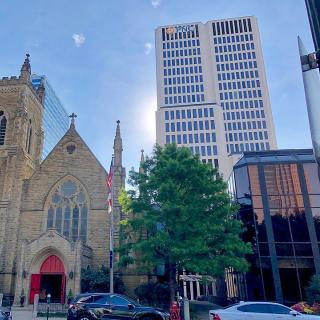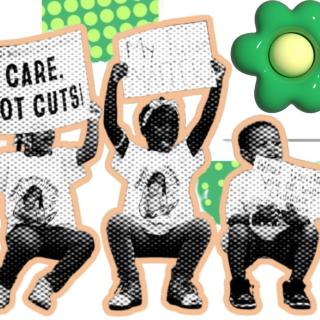It’s easy to nowadays to casually flip through the newspaper, “Such a shame,” we say. Crying babies and images of ICE agents cover the front page. “Too bad, those poor kids.” And yet we turn to the next page; these are only problems in border states. Besides, it doesn’t affect us...right?
Each day, it seems, new foreign policy changes appear in the newspaper headlines: increased border security to deter Central American illegal immigration, harsher and speedier deportation laws, the end of the DACA program, as well as the proposed travel ban which would limit travelers and immigrants from Chad, North Korea Venezuela, Iran, Libya, Somalia, Syria, and Yemen.
We skim these headlines, our eyes glancing over writers addressing important questions; What would America be without its immigrants? More importantly, how would the immigrant policies affect our local communities?
Sitting in the comfort of my dorm room on my Midwestern liberal arts college campus, these issues seem so foreign; it’s easy to ignore the effects that these laws have when the problem isn’t staring us in the face. But it is important to realize that while Trump’s immigration policies do have national and international implications, they also do and will leave detrimental effects on our local city of Columbus, effects that aren’t really foreign at all.
Immigrants and refugees in Columbus, Ohio make up almost 9.3% of the local population. The majority of these refugees (53%) are from Somalia, and many are also undocumented from Latin America (Anon 2018). Trump’s travel ban would prevent these Somalian refugees from coming to Columbus, and his controversial border policies and deportation would remove the thousands of undocumented immigrants, negatively affecting the Columbus economy and culture.
Often, we hear immigrants are stealing American jobs, acting as a burden on the tax system. In reality, their presence is economically beneficial. Columbus has three agencies that specialize in placing immigrants and helping to acclimate them to the American culture. These agencies spend about $6 million of federal money each year (Pyle 2015). However, immigrants in Columbus have $3 billion in spending power and contribute about $1.2 billion in taxes (Anon 2018).
The strength this money brings to the Columbus area helps to support local businesses, increases community services and attracts business investment. The Central Ohio region has over 870 refugee-owned businesses. Local refugees have played a role in creating over 21,273 jobs in the region, proving that their presence in Columbus is extremely beneficial (Pyle 2015).
Dr. David Walker and Jack Schemenauer, professors at Ohio Wesleyan University, describe the term ‘immigrantification’ in their journal titled “Immigrant Social-Economic Landscape Changes and Ethno-Racial Border Formation in Columbus, Ohio.” Immigrantification describes the positive effect immigrants have in reviving struggling areas. According to the article, as immigrants move into affordable housing often located in dilapidated neighborhoods, they bring with them revitalization and energy; the downtown district we know today would look radically different without our immigrant and refugee populations.
Refugees and immigrants also make up a major part of Columbus culture. Immigrants have established cultural communities all around the city, creating niche communities among Somali, South American and Latin American immigrants. In addition to the 873 refugee-owned businesses, many ethnic restaurants and festivals have created a vibrant Columbus food scene. Food Adventures, a_ shuttles consumers to immigrant-owned restaurants in the Northland District, pulling many visitors from around the area to sample the ethnic cuisine. Cultural celebrations occur all throughout the year, bringing in tourists and helping to contribute to a vibrant economic and cultural experience.
President Trump overlooks these economic and cultural benefits, instead declaring immigrants “rapists,” “drug dealers,” and “criminals.” However, in a project led by Robert Adelman, a sociologist professor at the State University of New York at Buffalo, researchers trends involving crime rates and immigration rates over the past few decades. They found that number of incoming immigrants in the Columbus area has increased by 282% since 1980. Violent crime rates, however, have fallen by 61%. Assaults, robberies, and murders have all fallen significantly as well (Flagg 2018).
So then why are we attacking immigrants if they pose no harm? If immigrants aren’t taking our jobs, but creating more, not choking, but reviving our city cultures, and not increasing crime rates, why are we looking to get rid of them?
The answer to these questions lays in a piece written by anthropologist George Foster titled, “Peasant Society and the Image of Limited Good.” In this essay, Foster proposed that people often view the world with the assumption that everything has an inherently limited value. Put simply, this means that if someone has more than me, then it must come at my expense. Trump’s declarations of immigrants taking something away from “true Americans” plays at this theory.
By stating that immigrants require government funding through monetary support, take jobs and employment from others, and will create new cultural niches, people assume that these additions come with reciprocal subtractions. An immigrant’s need for government money is not being taken from anywhere else; it is an investment. An immigrant’s need for employment does not mean they are taking jobs from others; they are creating more jobs and filling needs. An immigrant’s newly created cultural niche does not mean they are erasing an already existing culture; they are simply diversifying and revitalizing the current culture.
As Trump's orders take effect, we are starting to see their very real implications. One of the five World Relief Offices, located in Columbus, closed its doors this past July leaving existing immigrant families stranded without support (Bosco 2018).
And as immigration begins to move from the front page of the newspaper to the back page, it is a subject that remains as important as ever. While we may be sheltered from the effects of Trump's policies, the changes are happening in our own communities and are affecting us in very real ways. It is imperative that we realize this and take notice, as immigrants and refugees truly are what makes the Columbus area great.
Bibliography
Anon. 2018. "Information About New Americans In Central Ohio." Columbus.gov. Retrieved April 10, 2018 (https://www.columbus.gov/Templates/Detail.aspx?id=2147494142).
Bosco, Tom. 2018. "World Relief Shutting 5 Offices, Including Columbus, Due To Cuts In Refugee Funding." ABC6. Retrieved April 10, 2018 (http://abc6onyourside.com/news/local/world-relief-shutting-5-offices-inc...).
Drinkwater, Stephen. 2010. “Immigration and the Economy.” National Institute Economic Review, 213. March 28, 2018
Flagg, Anna. 2018. "The Myth Of The Criminal Immigrant." Nytimes.com. Retrieved April 12, 2018 (https://www.nytimes.com/interactive/2018/03/30/upshot/crime-immigration-...).
Foster, G. M. (1965), Peasant Society and the Image of Limited Good. American Anthropologist, 67: 293-315. doi:10.1525/aa.1965.67.2.02a00010
Pyle, Encarnacion. 2015. "Refugees Bring Economic Boost To Central Ohio, Supporters Say." The Columbus Dispatch. Retrieved April 13, 2018 (http://www.dispatch.com/content/stories/local/2015/09/17/refugees-impact...).
Walker, David M. Dr. and Schemenauer, Jack (2014) "Immigrant Social-Economic Landscape Changes and Ethno-Racial Border Formation in Columbus, Ohio," Cultural Encounters, Conflicts, and Resolutions: Vol. 1: Iss. 2, Article 4.
Winders, Jamie. 2016. “Immigration and the 2016 Election.” Southeastern Geographer, 56 (3). March 28, 2018 (http://0-www.jstor.org.dewey2.library.denison.edu/stable/pdf/26233803.pd...)



